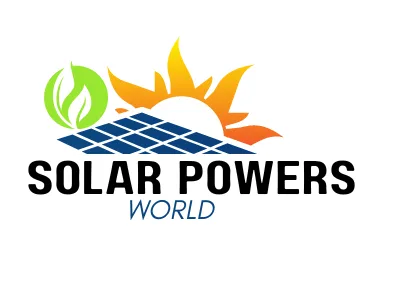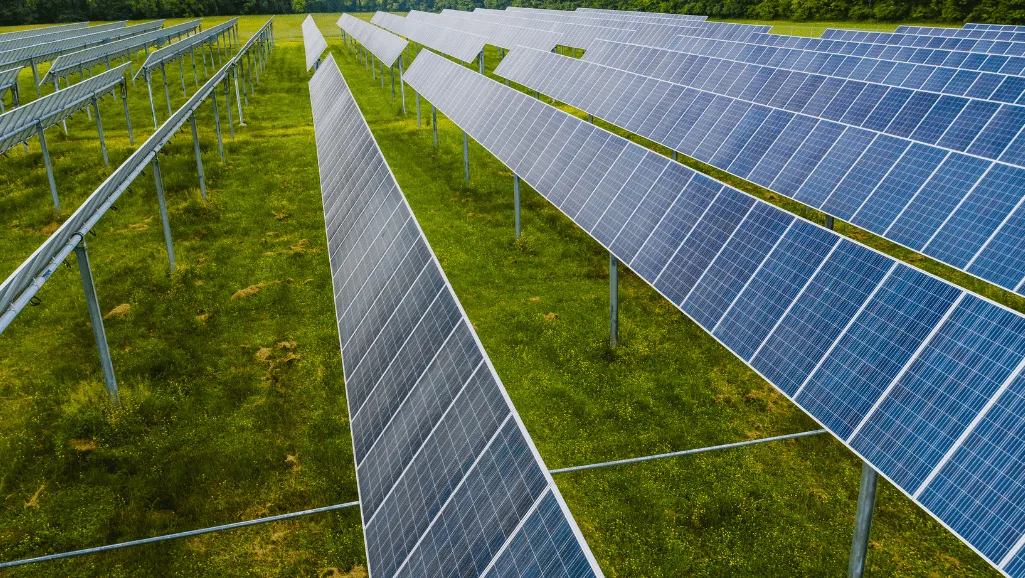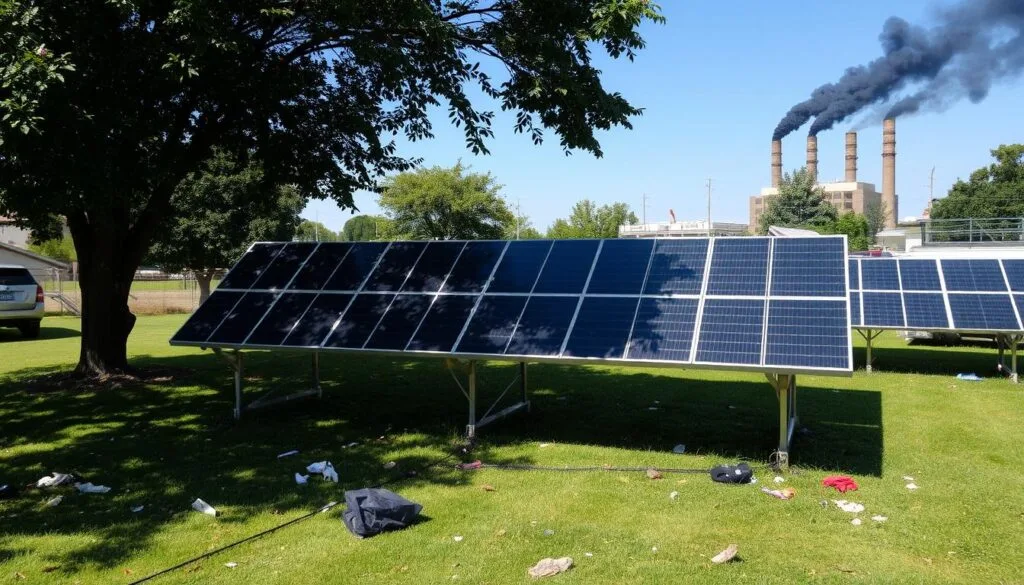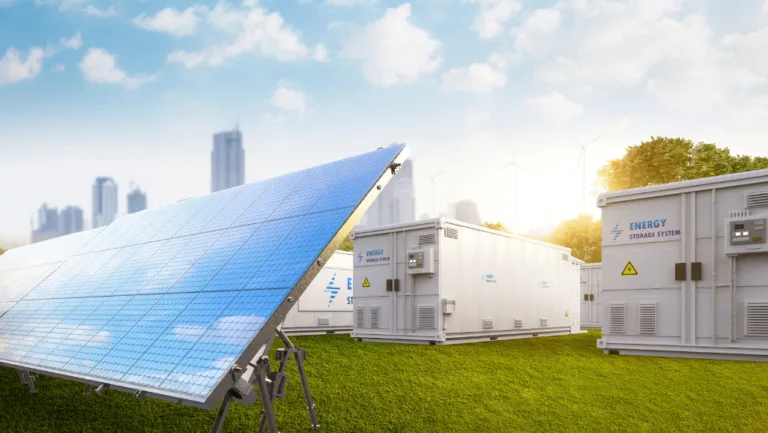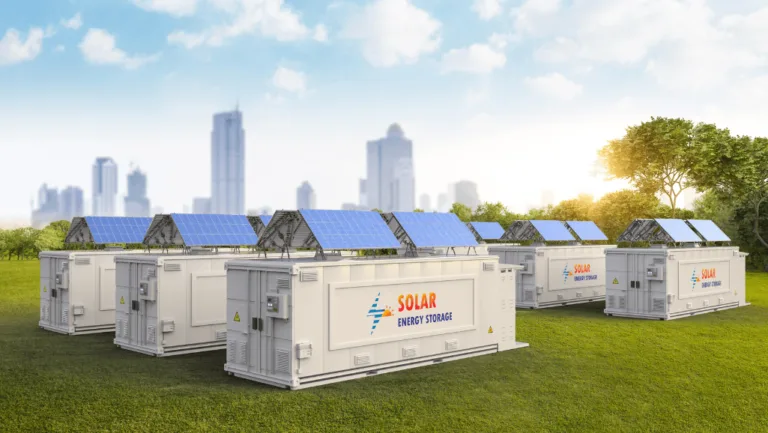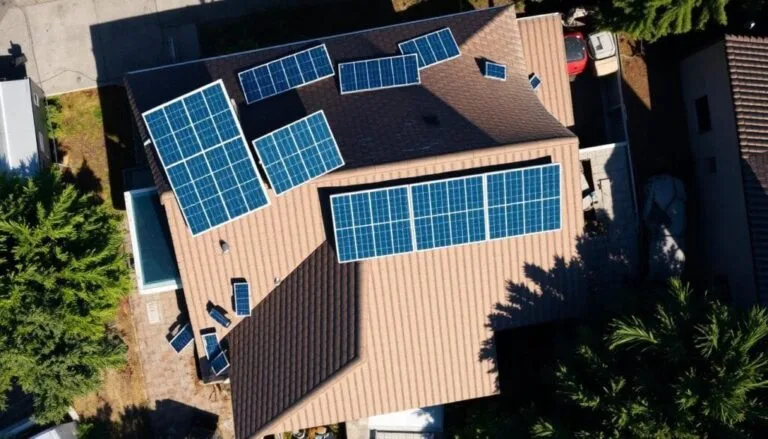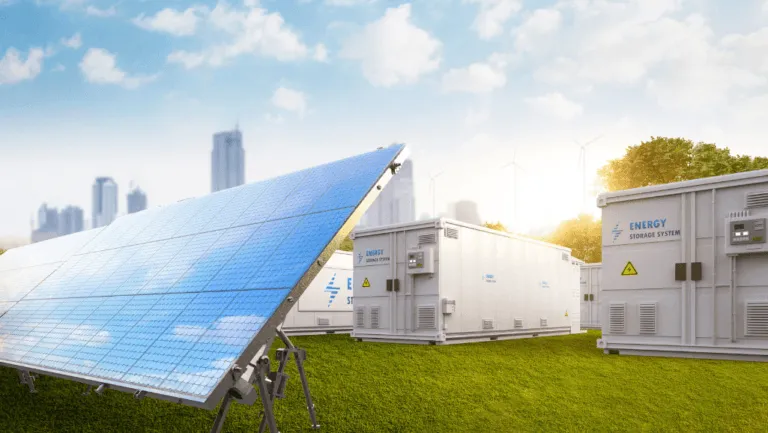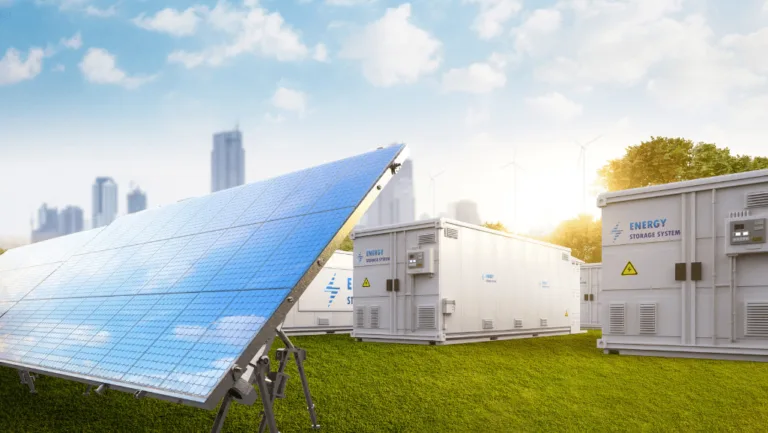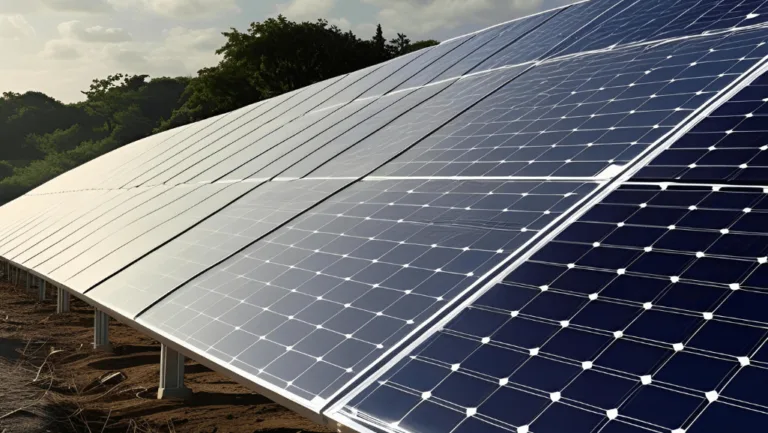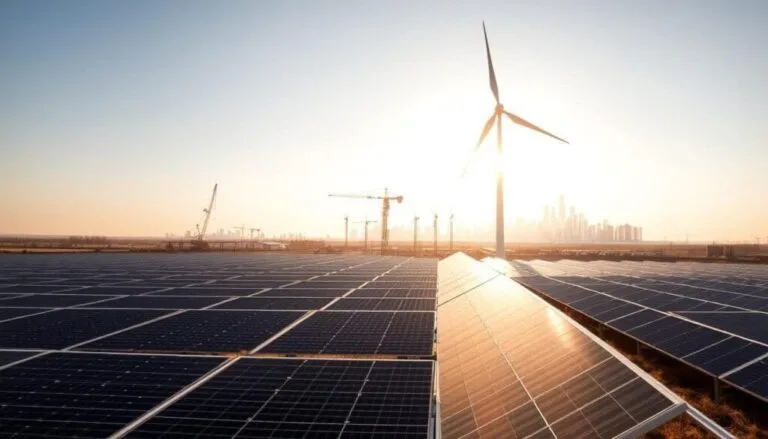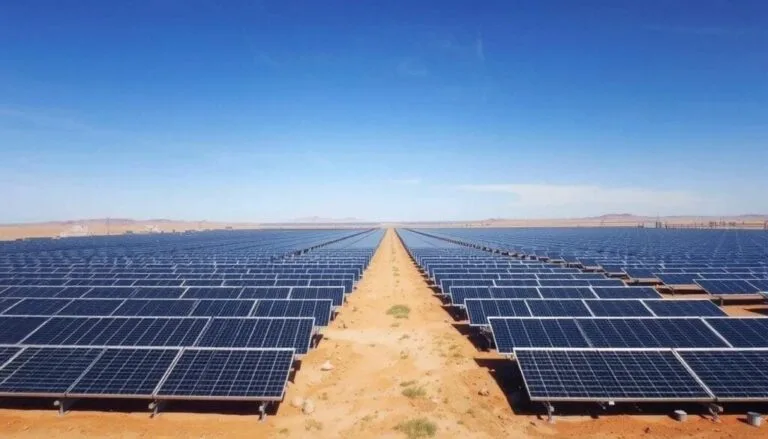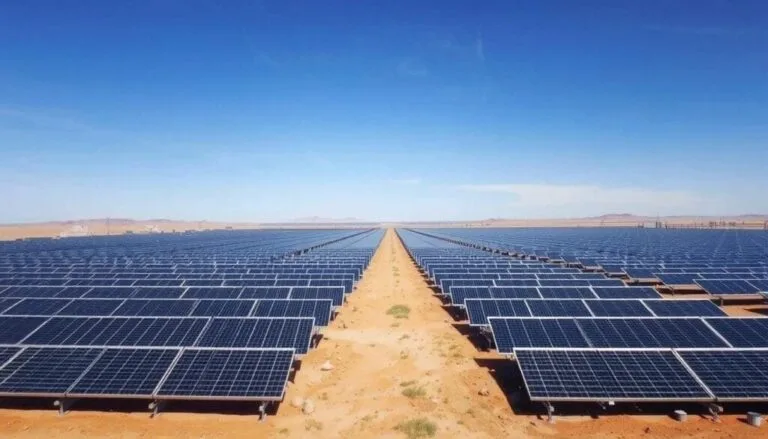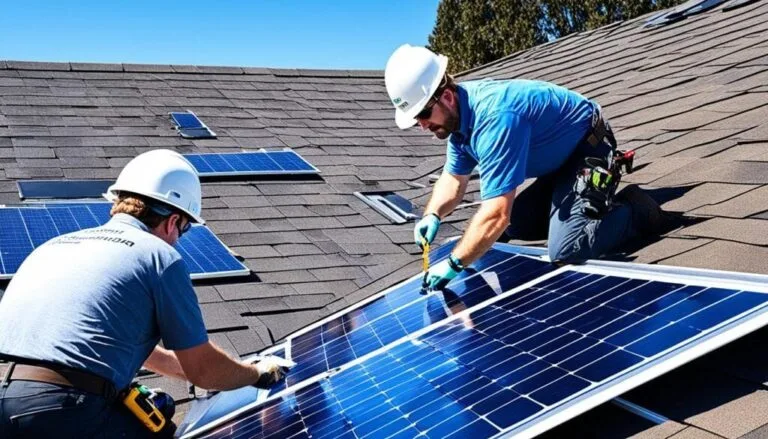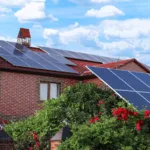As we talk more about solar power and renewable energy, a big question comes up: is the sun a renewable source of energy? The sun makes about 620 million metric tons of hydrogen fuse every second. This shows that solar energy is not only plenty but also keeps getting replenished.
Even though only a tiny part of the sun’s energy comes from the CNO cycle, its steady output makes it an endless source. Plus, about 30 percent of the solar energy that hits Earth gets sent back into space. This proves that solar power is truly renewable and stands out as a key source of energy. The sun shines brightly, showing us a future that’s sustainable and free from the limits of fossil fuels.
Key Takeaways
- The sun’s fusion process validates its status as a perpetual energy provider.
- Exceptional volumes of solar energy are generated and remain untapped.
- The discovery of photovoltaics, dating back to 1839, revolutionized the harnessing of solar power.
- Solar technology aids in critical daily tasks such as water sanitation and food preparation.
- Implementing solar energy reduces reliance on non-renewable resources, diminishing carbon footprints.
- Net metering permits homeowners to contribute surplus solar electricity back to the grid.
- Solar panels showcase a significant, extended lifespan paralleled by reduced carbon emissions.
Understanding Renewable vs Non-Renewable Energy
As we aim for a sustainable future, knowing the difference between non-renewable and renewable energy is key. Green energy is getting more important, making it vital to understand these sources. This knowledge helps us make better choices and shape policies.
Defining Non-Renewable Resources
Non-renewable resources like coal, oil, and natural gas are crucial but limited. For instance, 20% of US electricity comes from coal, but it’s not endless and harms the environment. Extracting these resources, such as drilling for oil, also hurts nature and affects ecosystems for a long time.
Nuclear power is also seen as non-renewable because uranium is not endless. It provides a lot of energy but raises debates on its long-term safety and waste disposal. New sustainable technologies show we need to move away from these old sources.
Characteristics of Renewable Energy
Renewable energy is endless and doesn’t harm the environment much. It includes solar, wind, and hydro power. These energies keep coming back, unlike non-renewable ones. The renewable energy characteristics help the planet, support independence, and create jobs. Plus, costs for things like solar panels have gone down, making green energy more popular worldwide.
Renewable energy is becoming more important in our energy mix, even with challenges like storing energy and fitting it into the grid. We need new ideas and rules to help renewable energy grow.
Here’s a table to show how non-renewable and renewable energy differ in the environment and economy:
| Energy Type | Common Sources | Environmental Impact | Economic Benefits |
|---|---|---|---|
| Non-renewable | Coal, Oil, Natural gas, Nuclear | High pollution, habitat disruption | Energy security (short-term) |
| Renewable | Solar, Wind, Hydro, Geothermal | Low pollution, sustainable | Job creation, long-term energy security |
Improvements in solar tech and other green energy sources are helping us switch to a sustainable energy model. This change is good for nature and ensures a healthier future for our kids and grandkids.
Is the Sun a Renewable Source of Energy?
The debate over is the sun renewable source of energy is key to our move to sustainable energy. Clearly, solar energy is seen as renewable because the sun never runs out on our timescale. Every hour, the sun gives us enough energy for a year, showing how big solar energy’s potential is.
Solar power uses this endless energy through photovoltaic cells and concentrated solar power. These methods turn sunlight into electricity without using up the sun’s energy. Unlike oil or coal, which we can’t keep using forever, solar power is always there.
| Renewable Energy | Comparative Carbon Footprint | Typical Lifespan |
|---|---|---|
| Solar Energy | Minimal | ~30 Years |
| Non-Renewable (Oil, Coal) | Significant | Finite Reserves (50 years) |
Solar energy is good for the planet because it’s a clean way to make energy. Solar panels don’t release much greenhouse gases, unlike old energy sources. Companies like Hoymiles are making solar tech better with things like microinverters and storage systems.
Sustainable energy from solar power meets our energy needs and helps cut down on carbon emissions. As technology gets better and we use more renewable energy, solar power shows it’s a great choice for our planet.
The Inherent Renewability of Solar Energy
The talk about solar energy renewability is based on the sun’s natural and endless power. Sunlight is a key source of power, making solar power a vital part of green energy plans around the world. This part looks at how solar energy keeps going and gives strong facts to back it up.
The Unlimited Nature of Solar Resources
Earth gets a huge 173,000 terawatts of solar energy, showing how much potential solar power has. This is more than 10,000 times what we use worldwide. The sun’s constant shine, set to last another 5 billion years, means solar energy won’t run out anytime soon. This is unlike fossil fuels, which will eventually be gone.
How Solar Energy Renews Itself
Solar energy is always coming back, like the water cycle. New tech has made solar panels cheaper, making solar energy more affordable. For example, solar cells have gotten 33% better in the last ten years, says the National Renewable Energy Laboratory (NREL).
- The lifecycle greenhouse gas emissions from solar energy are very low, between 20 to 70 grams of CO2 equivalent per kilowatt-hour. This is much less than from natural gas and coal.
- Good solar panels still work at about 88% after 25 years, showing they last a long time and are a good choice.
- Switching to solar power for an average U.S. home is like planting 125 trees a year or cutting down on emissions by 8,440 pounds of coal a year.
Solar energy’s renewability shows it’s a sustainable energy source that helps the environment. With ongoing tech improvements and efforts to reduce emissions, solar power is a key green energy option.
The Environmental Impacts of Solar Power
The rise of solar power as a clean energy source highlights its environmental effects. It’s known for cutting down the carbon footprint of energy making. Yet, we must look closely at the whole life cycle and sustainability of solar tech.
Comparing Carbon Footprints: Solar vs Fossil Fuels
Solar power greatly reduces carbon footprint when compared to old fossil fuels. A typical PV system pays back the energy used to make it in just 1 to 4 years. With a lifespan of 30 years or more, the net effect on carbon footprint reduction is huge. Solar energy keeps producing clean energy without harmful emissions, making it a key player in reducing pollution.
To learn more about the environmental impact of solar energy, check out this link.
Offsetting the Manufacturing Process’ Carbon Emissions
The energy and resources used to make solar panels are quickly offset by the clean energy they produce over their life. Recycling solar panels is now encouraged in many states, showing solar’s green credentials. The U.S. Department of Energy’s Solar Energy Technologies Office (SETO) is working to make solar projects better for the environment.
They’re studying how solar panels affect wildlife and improving soil health. These efforts aim to lessen the environmental impact of solar projects.
Choosing the right places for solar panels helps avoid harming habitats. The AgriSolar Clearinghouse is exploring how to use land for both farming and solar power. This approach can make farming more profitable and use land wisely.
Switching to solar power is a big step towards clean energy and taking care of our planet. The mix of tech and green thinking in solar energy is getting better. It shows how important it is to balance our ecological and tech goals for energy.
Solar Panels: Harnessing the Power of the Sun
Solar panels have come a long way from their early days to now being a key part of our energy solutions. They work thanks to the photovoltaic effect, first found by Edmond Becquerel. This effect lets us turn sunlight into electricity, making solar power a key part of our sustainable future.
The Photovoltaic Effect and its Discovery
The photovoltaic effect is how solar panels turn sunlight into electricity. When sunlight hits silicon in the panels, it frees electrons, creating electricity. This discovery in 1839 was a big step towards using sunlight as a clean energy source.
The Evolution and Advances in Solar Technology
Since the first practical solar cell in 1954, solar tech has grown a lot. Research and new materials have made solar panels more efficient and cheaper. Now, solar energy can power homes, utilities, and even cars.
Today, solar panels fit into many places, from rooftops to big solar farms. They show how flexible and adaptable solar energy can be. With new systems like dual cooling and power strategies, solar energy is getting even better.
Advances in solar tech include better energy storage solutions like batteries. These systems help use solar energy even when the sun isn’t shining, making power more reliable. This shows how solar energy is key to a sustainable future.
Learning about solar panels and the photovoltaic effect helps us see how sunlight turns into clean power. As solar tech keeps getting better, the future of energy looks bright. Solar panels are leading the way to a greener, more sustainable world.
The Role of Solar Farms in Renewable Energy Production
Solar farms are key in renewable energy production. They use many photovoltaic panels to efficiently capture solar energy. These big installations, or solar parks, help increase the use of green energy. They turn sunlight into electrical energy and add it to the power grid, helping us use cleaner energy sources.
Solar parks are big and well-planned, cutting down on fossil fuel use. This helps the world fight against greenhouse gas emissions. For example, the Oberon Solar Power Facility in West Texas is huge, big enough to power 30,000 homes every year.
Community solar programs are great for local energy needs. They use smaller solar farms that make about 5 MW of power. This lets people enjoy solar power without having panels at home, helping the community support green energy.
The move to solar parks is huge. From 2010 to 2020, solar PV technology grew from over 40,334 MW to 709,674 MW worldwide. This shows how solar farms are key in moving to a renewable energy future. For more on solar technology, check out the pros and cons of solar.
| Year | Installed Capacity (MW) |
|---|---|
| 2010 | 40,334 |
| 2020 | 709,674 |
Solar technologies are getting cheaper, making solar farms more popular. From 2010 to 2018, the cost of solar PV plants dropped by 77%. This makes it easier for more places to switch to solar energy, making solar farms a key part of renewable energy plans.
Solar Energy Efficiency on Cloudy Days
Solar panels work well even when it’s not super sunny. Photovoltaic cells can still make energy on cloudy days. This shows how strong and flexible solar technology is, making it a key part of renewable energy.
On cloudy days, solar panels make about 10% to 25% of the electricity they do on sunny days. This is because photovoltaic cells can catch sunlight that goes through the clouds. Some panels are made to work better in cloudy weather, keeping the energy flow steady.
The Impact of Weather Conditions on Solar Panel Output
Cloudy day solar output is important for those thinking about solar power. Solar panels usually make 250 to 400 watts per panel in the best conditions. But, they make less power when it’s cloudy. Still, new solar tech has made panels work better, even in fog.
Places like Germany show how solar power can work well, even with lots of cloudy days. Germany gets about 25% of the world’s solar power, proving solar energy works everywhere, not just in sunny places.
Systems like net metering and solar batteries make solar setups even better. Net metering lets people send extra energy back to the grid and get credits. Solar batteries store extra power for when you need it, like on cloudy days or at night.
Using energy-saving devices and smart home energy use also boosts solar power. Things like smart thermostats and energy-saving lights work well with solar power. This helps save more energy and makes solar energy even more effective.
New tech in photovoltaic cells and system designs is making solar power better all the time. This makes solar power a great choice for places that don’t get a lot of sun. It’s a key part of renewable energy that works well no matter the weather.
Leaders in Global Solar Energy Production
The world of global solar energy production is changing fast. It’s moving towards renewable energy, thanks to big steps by solar power leaders. Solar power is becoming key in the fight against climate change. It helps us meet our goals to cut down on carbon emissions.
China and Germany are leading the way in solar energy. They’re making big moves in the solar field. Home solar installations are on the rise. More people are choosing solar power, saving money on energy bills and pushing for new solar tech.
Assessing the Scale of Worldwide Solar Power Generation
China has almost doubled its solar power capacity, aiming to hit a 2030 goal early. Morocco’s Noor-Ouarzazate solar farm is one of the biggest in the world. It shows Africa’s potential in solar energy. These efforts boost local industries and make these countries leaders in solar power.
When we talk about renewable energy sources, solar power is key. The European Union now gets more electricity from wind and solar than natural gas. This shows a strong support for renewable energy in leading regions.
The story of solar power is about tech progress and working together for a green future. The achievements of these countries guide us towards a future powered by renewable energy sources.
Sustainable Practices in Solar Energy Use
Using sustainable solar energy practices is key for our planet. We need to make solar panels last longer and recycle them well. This helps us use resources wisely and protect the environment.
Understanding how long solar panels last is important for the planet. Thanks to new technology, solar panels can work well for over 30 years. This means less waste and fewer replacements.
Maximizing Solar Panel Lifespan and Recycling
Keeping solar panels working well is crucial. We do this with quality making, correct setup, and regular checks. After they’re done working, solar recycling is key. It turns old panels into new ones, saving raw materials.
Strategies for Reducing Solar Energy’s Environmental Footprint
We need to lessen the harm solar energy does to the planet. This means using solar with other green sources for better energy. It’s good for the planet and helps our wallets too. Plus, sharing energy in communities means we don’t lose power when we make too much.
| Factor | Impact | Strategy |
|---|---|---|
| Solar Panel Manufacturing | Use of non-toxic materials | Develop non-hazardous material standards |
| Energy Production | Carbon emission reduction | Enhance efficiency of photovoltaic cells |
| End-of-Life Cycle | Toxic waste mitigation | Increase recycling facilities |
Using the sun’s power is vital, and we must support solar energy as a key part of our lives. This way, we cut down on harmful gases and help our planet for the future.
Conclusion
The sun is a key player in the move to sustainable energy. It has a huge potential and will last a long time. Solar power has many benefits, like producing only 40 grams of carbon dioxide per kWh. This is much less than what coal power plants do, which release over 1,000 grams per kWh.
Solar power is also good for the planet and helps save resources. Solar panels last up to 25 years and need little upkeep. They don’t use water to work, unlike coal which uses a lot. This helps save water.
The cost of solar panels is going down, making solar energy more affordable for everyone. This means people can save money on their energy bills. The EcoFlow solar generator is a great example of how solar power is changing the game.
We rely on the sun as a limitless resource, which means solar energy could soon be the main way we get power. This is good for the planet, the economy, and communities that need electricity. Solar energy is key to a sustainable future.

